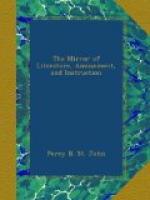There is a small spring which oozes from under the rocks behind the great palace of the Sherif, called Beit el Sad; it is said to afford the best water in this country, but the supply is very scanty. The spring is enclosed, and appropriated wholly to the Sherif’s family.
Beggars, and infirm or indigent hadjys, often entreat the passengers in the streets of Mekka for a draught of sweet water; they particularly surround the water-stands, which are seen in every corner, and where, for two paras in the time of the Hadj, and for one para, at other times, as much water may be obtained as will fill a jar.—Burckhardt’s Travels in Arabia.
* * * * *
THE NATURALIST.
[Illustration: FLAKES OF SNOW MAGNIFIED.]
Snow is one of the treasures of the atmosphere. Its wonderful construction, and the beautiful regularity of its figures, have been the object of a treatise by Erasmus Bartholine, who published in 1661, “De Figura Nivis Dissertatio,” with observations of his brother Thomas on the use of snow in medicine. On examining the flakes of snow with a magnifying glass before they melt, (which may easily be done by making the experiment in the open air,) they will appear composed of fine shining spicula or points, diverging like rays from a centre. As the flakes fall down through the atmosphere, they are joined by more of these radiated spicula, and thus increase in bulk like the drops of rain or hail-stones. Dr. Green says, “that many parts of snow are of a regular figure, for the most part so many little rowels or stars of six points, and are as perfect and transparent ice as any seen on a pond. Upon each of these points are other collateral points set at the same angles as the main points themselves; among these there are divers others, irregular, which are chiefly broken points and fragments of the regular ones. Others also, by various winds, seem to have been thawed and frozen again into irregular clusters; so that it seems as if the whole body of snow was an infinite mass of icicles irregularly figured. That is, a cloud of vapours being gathered into drops, those drops forthwith descend, and in their descent, meeting with a freezing air as they pass through a colder region, each drop is immediately frozen into an icicle, shooting itself forth into several points; but these still continuing their descent, and meeting with some intermitting gales of warmer air, or, in their continual waftage to and fro, touching upon each other are a little thawed, blunted, and frozen into clusters, or entangled so as to fall down in what we call flakes.” But we are not, (says the author of the “Contemplative Philosopher,”) to consider snow merely as a curious phenomenon. The Great Disposer of universal bounty has so ordered it, that it is eminently subservient, as well as all the works of creation, to his benevolent designs.




